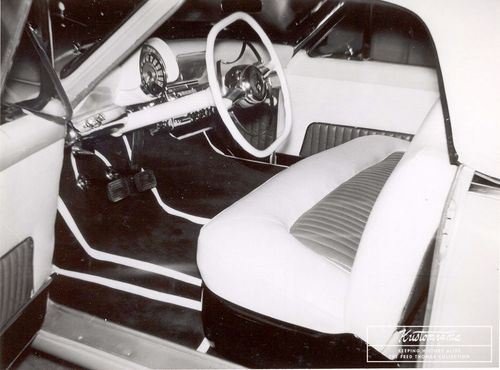The Fred Thomas Photo Collection












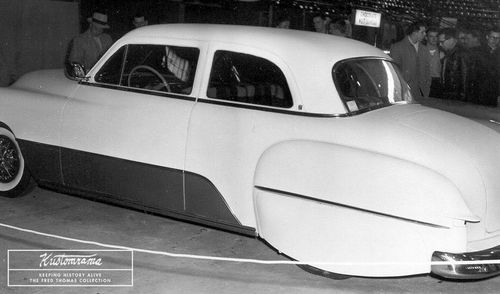



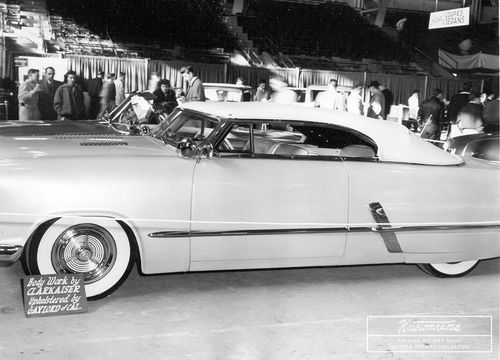



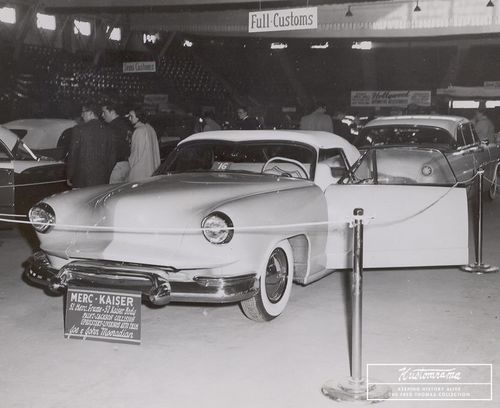




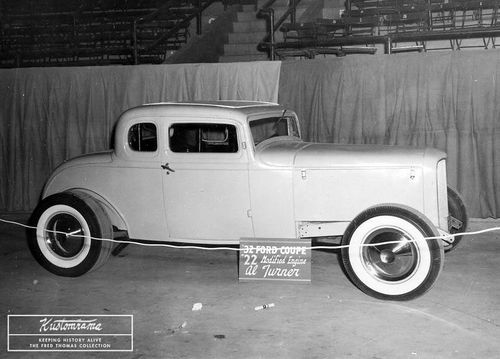


Fred Thomas is the author of the book Car Club Memories: Personal stories from three dynamic decades of Cruisin’ Competition and Cool Cars. Cars have always been an integral part of Fred's life. From 1947 until 1965 most of his life was spent in Ypsilanti, Michigan. A typical Midwestern town. After the war, Kaiser-Fraser automobiles were produced in town, and in 1947, when he was six years old, his father started a used car business. "With the war having ended only two years earlier, and automobiles being a scarce commodity, the opportunity to make money lured him away from barbering, a profession to which he never returned," Fred wrote in his book.[2]
Contents
- 1 Cecil's Auto Sales
- 2 Playing Around in the Garage
- 3 First Car
- 4 A Victim of the Hot Rod Bug
- 5 Buying and Selling Cars
- 6 The Black Ford
- 7 A Mild Custom Treatment
- 8 The Price Was Right!
- 9 Car Club Memories: Personal stories from three dynamic decades of Cruisin’ Competition and Cool Cars
- 10 References
Cecil's Auto Sales
The modern shop and surroundings of Cecil's Auto Sales became Fred's childhood playgrounds. "In the overgrown fields behind the garage, several “junkers” found final resting places. How- ever, before being scrapped completely, they served as military vehicles for a platoon of youthful neighborhood soldiers. I still vividly remember playing war, with the up-sided carcasses serving as tanks. Occasionally windshields and door glasses became casualties of projectiles hurled by “enemy troops”. Amazingly, I do not recall being punished for the damage we caused, but verbal reprimands were faced for more than one mindless “accident”."[2]
Playing Around in the Garage
Fred had free rein in the garage. "While other kids had trucks and games to amuse them, my playthings were wrenches, spray guns, and sanding blocks. At home I also possessed boys’ toys, but preferred instead to entertain myself with body refurbishing tools." At a young age, Fred knew how to start vehicles, and had mastered the three-speed column shift pattern. By the time he was twelve, he could drive a car by himself.[2]
First Car
In the summer of 1954, Fred's father bought a black model A Ford coupe, "and labeled it mine. He paid seventy-five dollars for it. At thirteen I was on cloud nine! It became my sole driving machine, home and back, home and back, home and back! Many times my boyish imagination transformed me into a race driver as the four-cylinder jalopy maneuvered those narrow serpentine tracks which attached home to my dad’s business, an eighth-mile away. Of course, I continued to drive the well-trodden roadway almost daily."[2]
A Victim of the Hot Rod Bug
The hot-rodding bug bit Jerry, Fred's fifteen-year-old brother, before it seriously attacked him. "This unfortunately led to the demise of the Model A. He and a school chum persuaded me to let them install a “full-race” four cylinder, model "B" Ford engine in the coupe. Anyone growing up under the influence of older siblings will understand why I put up no resistance. They were buying the mill from a "hot rodder" who was replacing it with a V-8. Well, the stocker got removed, but the hot four-banger never reached its new home. Good intentions weren't enough for the teenage lads with no one to guide them. I recall how upset dad got upon discovering the unfinished project in the field near the garage. The next time the scrap iron crew picked up the "junker" carcasses, the Model A mysteriously disappeared. No explanation was ever offered, and none was ever requested. Somehow we knew better than to mention it."[2]
Buying and Selling Cars
During the summer between his sophomore and junior years of high school, Fred bought, upgraded, and sold four cars, with his father's guidance. Each vehicle would require five or six days to get ready. By fifteen he had painted his first car solo. "I usually netted $100 per vehicle. That was excellent money for a fifteen-year-old to be earning!" After accumulating $350.00, the chance to purchase a small boat came Fred's way. Pat Cook, a friend of Fred, owned a 1947 Ford Coupe, and the summer of 1956 his blur bomb towed the little craft to Belleville Lake, every weekend.[2]
The Black Ford
In 1957 Michigan began offering driver's education courses in high schools. While Fred technically didn't need the requirement, it seemed like a good idea to take the instructions. January 22, 1957 Fred went to the local county sheriff's office annex in Willow Village where the written examination and accompanying road test were to be taken. "Needless to say, I passed them both!" Fred's parents allowed him to drive everywhere after he became licensed. The next two months he mainly drove "lot cars." He had adopted a 1950 Mercury Tudor from his dad's business that suffered from a power deficiency. Fred never got the Mercury in shape, and the project was abandoned in favor of a black 1950 Ford two-door that came into his dad's lot. "It was splendid, a one-owner car with only 24,000 miles on the speedometer. Its 100 horsepower motor purred at an idle. The light gray interior showed absolutely no wear. The exterior surfaces exhibited no accident damage. However, road salt from several Michigan winters had taken its toll on the rocker panels. I knew I could replace them. What a beauty it was to the eyes of this young, car-crazy kid!" Fred's dad told him he could buy the well-preserved car if he wanted to. The purchase price was $233.74, "exactly what the Sesi Lincoln-Mercury dealership had charged for it." Fred's dad suggested he could sell the hydroplane to get funds for the car.[2]
A Mild Custom Treatment
Fred bought the Ford in April of 1957. "Most of my spare time was spent working on it. Cleaning the inside, washing and polishing the exterior, changing the oil, and making mild modifications consumed my life. When I hit the road, it had to look its best, so others would appreciate it as I did. Often I would ad- mire its shiny reflection as I cruised by large store windows." An experienced body man from the local Lincoln-Mercury dealership, that used to moonlight for his dad, helped Fred install new rocker panels on the car. "A bull nose hood molding smoothed the frontal appearance. A stubby antenna was relocated to the left rear quarter. Parking light bulbs were tinted blue. Chrome headlight and taillight rims were painted black to match the car. That gave them a “frenched” look." Cut coil springs and lowering blocks brought the profile down. "Full ripple wheel discs fore and handcrafted, sheet metal fender skirts aft completed the exterior enhancements. I always wondered if Jimmy Jones, the bubble skirt creator from nearby Inkster, Michigan, made the pair I owned. I had no proof as I purchased them used."[2]
The Price Was Right!
"We purchased used parts from Diehl Wreckers in Ann Arbor. The job of picking them up often fell on my shoulders. After many trips back and forth I discovered a shortcut that took me through the North Campus of the University of Michigan. In the fall of 1959 during one such traversal I spotted a gray-primer ’47 Chevrolet four door. From a distance I immediately recognized that the front end had been refashioned." Out of curiosity, Fred just had to take a look. "I couldn’t believe what I saw. The license plate showed it was, indeed, a California custom!"[2]
The front end on the Chevrolet had two hand-formed openings into which custom grill bars had been centered. "The headlights were frenched and also uniquely shaded. All chrome had been removed; hood, trunk, door handles, and side trim. Only the rocker panel trim remained. Shaded ’50 Buick taillight lenses replaced the stock units. The rear fenders had been molded-in. Single-blade chrome wheel covers enhanced the four door’s design. The interior was upholstered in black and white vinyl. All interior window moldings were chrome plated. The stock shift lever had been converted over to function on the left-hand side." Later, Fred was informed that in addition to all the interior and exterior changes, the motor had been hopped up as well. "It was bored .060 over. Jahns pistons, a Howard ¾ cam, and a Tattersfield dual carb intake manifold added horsepower to the standard six. The exhaust manifold had been split and dual pipes added."[2]
Was it for sale? Fred never stopped to consider how much it might cost, if it were. "I left my name and phone number on a scrap of paper tucked under a windshield wiper blade."[2]
The next day Fred got a call. "The Cal owner was finishing graduate work and intended to drive back to San Bernardino. However, he was willing to consider selling the Chevy. I worked up the courage to ask the price. When he said, "Two hundred sixty dollars", I didn’t believe what I heard. I asked him to repeat the price, and the answer was the same, "Two hundred sixty dollars". I assured him I would take it. We arranged a time for me to pick it up in two days."[2]
Fred enjoyed the custom until May of 1960, when he went into the Army. "Selling the modified automobile was not as easy as you might think. I tried in vain to get $550. our or five youths wanted it, but couldn’t come up with the bucks. In desperation it went to a good friend for $300. He put $100 down and promised to send me $25 a month until it was paid for."[2]
Car Club Memories: Personal stories from three dynamic decades of Cruisin’ Competition and Cool Cars
When Fred got his first custom, his ego depended on his restyled Ford. "I could feel my chest swell whenever someone made a complimentary remark about it. Whether cruising the local high schools or the drive-in restaurants, the Ford provided me advance recognition. Friends saw it coming and knew immediately who was driving. I was the car, and it was me!" Since April of 1957, hot rods and custom cars have been an integral part of Fred's life. In 1998 he undertook a multi-year research project to record the names and locations of hot rod and custom car clubs which existed prior to 1970. He documented over 9,000 of them. During his research he had the opportunity to solicit personal stories from a number of former club members across the U.S. In 2008, after ten years of hard work, Fred finally published the book Car Club Memories: Personal stories from three dynamic decades of Cruisin’ Competition and Cool Cars. Fred's book is a trip back down memory lane to the earlier days of hot rodding. Car Club Memories shares personal stories of young men and their car related adventures. The anecdotes and snapshots make up Fred's book. Using the photos and stories he had collected, he was able to write biographical sketches and had them approved by the respective donors prior to the book’s publication. He also included some of his own experiences. The book has 116 pages and it containes 165 vintage black and white photos. It has become hard to come by, but it is a good read, and we recommend you all to check it out. Click here to check price and availability on Amazon.com.
Fred has been kind enough to share much of his material with Kustomrama, and on this page you will find photos and stories from Fred's book, along with rare photos and stories that didn't make it into the book. Enjoy!
References
Did you enjoy this article?
Kustomrama is an encyclopedia dedicated to preserve, share and protect traditional hot rod and custom car history from all over the world.
- Help us keep history alive. For as little as 2.99 USD a month you can become a monthly supporter. Click here to learn more.
- Subscribe to our free newsletter and receive regular updates and stories from Kustomrama.
- Do you know someone who would enjoy this article? Click here to forward it.
Can you help us make this article better?
Please get in touch with us at mail@kustomrama.com if you have additional information or photos to share about The Fred Thomas Photo Collection.
This article was made possible by:
SunTec Auto Glass - Auto Glass Services on Vintage and Classic Cars
Finding a replacement windshield, back or side glass can be a difficult task when restoring your vintage or custom classic car. It doesn't have to be though now with auto glass specialist companies like www.suntecautoglass.com. They can source OEM or OEM-equivalent glass for older makes/models; which will ensure a proper fit every time. Check them out for more details!
Do you want to see your company here? Click here for more info about how you can advertise your business on Kustomrama.

